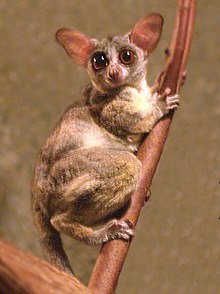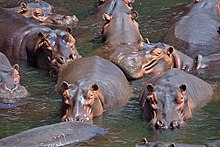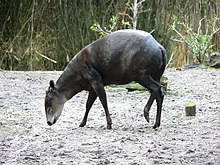Wildlife of Rwanda

The Wildlife of Rwanda includes its flora and fauna and their natural habitats. It has 189 species of mammals and 729 species of birds.
Subclass: Theria
Infraclass: Eutheria
Order: Tubulidentata (aardvarks)
The order Tubulidentata consists of a single species, the Aardvark. Tubulidentata are characterised by their teeth which lack a pulp cavity and form thin tubes which are continuously worn down and replaced.
- Family: Orycteropodidae
- Genus: Orycteropus
- Aardvark Orycteropus afer LC
- Genus: Orycteropus
- Family: Orycteropodidae
Order: Hyracoidea (hyraxes)
The hyraxes are any of four species of fairly small, thickset, herbivorous mammals in the order Hyracoidea. About the size of a domestic cat they are well-furred, with rounded bodies and a stmpy tail. They are native to Africa and the Middle East.
- Family: Procaviidae (hylaxes)
- Genus: Dendrohyrax
- Western Tree Hyrax Dendrohyrax dorsalis LC
- Genus: Heterohyrax
- Yellow-spotted Rock Hyrax Heterohyrax brucei LC
- Genus: Dendrohyrax
- Family: Procaviidae (hylaxes)
Order: Proboscidea (elephants)
The elephants comprise three living species and are the largest living land animals.
- Family: Elephantidae (elephants)
- Genus: Loxodonta
- African Bush Elephant Loxodonta africana VU
- Genus: Loxodonta
- Family: Elephantidae (elephants)
Order: Primates



The order Primates contains all the species commonly related to the lemurs, monkeys, and apes, with the latter category including humans. It is divided informally into three main groupings: prosimians, monkeys of the New World, and monkeys and apes of the Old World.
- Suborder: Strepsirrhini
- Infraorder: Lorisiformes
- Family: Lorisidae (lorises, bushbabies)
- Genus: Perodicticus
- Potto Perodicticus potto LR/lc
- Genus: Perodicticus
- Family: Galagidae
- Genus: Galago
- Demidoff's Dwarf Galago Galago demidoff LR/lc
- Eastern Needle-clawed Bushbaby Galago matschiei LR/nt
- Mohol Galago Galago moholi LR/lc
- Senegal Bushbaby Galago senegalensis LR/lc
- Thomas's Bushbaby Galago thomasi LR/lc
- Genus: Otolemur
- Brown Greater Galago Otolemur crassicaudatus LR/lc
- Genus: Galago
- Family: Lorisidae (lorises, bushbabies)
- Infraorder: Lorisiformes
- Suborder: Haplorrhini
- Infraorder: Simiiformes
- Parvorder: Catarrhini
- Superfamily: Cercopithecoidea
- Family: Cercopithecidae (Old World monkeys)
- Genus: Cercopithecus
- Chlorocebus Cercopithecus aethiops LR/lc
- Black-cheeked White-nosed Monkey Cercopithecus ascanius LR/lc
- Hamlyn's Monkey Cercopithecus hamlyni LR/nt
- L'Hoest's Monkey Cercopithecus lhoesti LR/nt
- Blue Monkey Cercopithecus mitis LR/lc
- Genus: Lophocebus
- Grey-cheeked Mangabey Lophocebus albigena LR/lc
- Genus: Papio
- Olive Baboon Papio anubis LR/lc
- Subfamily: Colobinae
- Genus: Colobus
- Angola Colobus Colobus angolensis LR/lc
- Mantled Guereza Colobus guereza LR/lc
- Genus: Colobus
- Genus: Cercopithecus
- Family: Cercopithecidae (Old World monkeys)
- Superfamily: Hominoidea
- Family: Hominidae (humans)
- Subfamily: Homininae
- Tribe: Gorillini
- Genus: Gorilla
- Eastern Gorilla Gorilla beringei EN
- Genus: Gorilla
- Tribe: Hominini
- Genus: Pan
- Common Chimpanzee Pan troglodytes EN
- Genus: Pan
- Tribe: Gorillini
- Subfamily: Homininae
- Family: Hominidae (humans)
- Superfamily: Cercopithecoidea
- Parvorder: Catarrhini
- Infraorder: Simiiformes
Order: Rodentia (rodents)
Rodents make up the largest order of mammals, with over 40 percent of mammalian species. They have two incisors in the upper and lower jaw which grow continually and must be keep short by gnawing. Most rodents are small though the capybara can weigh up to 45 kg (100 lb).
- Suborder: Hystricognathi
- Family: Hystricidae (Old World porcupines)
- Genus: Hystrix
- Cape Porcupine Hystrix africaeaustralis LC
- Genus: Hystrix
- Family: Thryonomyidae (cane rats)
- Genus: Thryonomys
- Greater Cane Rat Thryonomys swinderianus LC
- Genus: Thryonomys
- Family: Hystricidae (Old World porcupines)
- Suborder: Sciurognathi
- Family: Sciuridae (squirrels)
- Subfamily: Xerinae
- Tribe: Xerini
- Genus: Xerus
- Striped ground squirrel Xerus erythropus LC
- Genus: Xerus
- Tribe: Protoxerini
- Genus: Funisciurus
- Carruther's Mountain Squirrel Funisciurus carruthersi LC
- Genus: Heliosciurus
- Red-legged Sun Squirrel Heliosciurus rufobrachium LC
- Ruwenzori Sun Squirrel Heliosciurus ruwenzorii LC
- Genus: Paraxerus
- Boehm's Bush Squirrel Paraxerus boehmi LC
- Genus: Protoxerus
- Forest Giant Squirrel Protoxerus stangeri LC
- Genus: Funisciurus
- Tribe: Xerini
- Subfamily: Xerinae
- Family: Spalacidae
- Subfamily: Tachyoryctinae
- Genus: Tachyoryctes
- Ruanda Mole Rat Tachyoryctes ruandae LC
- Genus: Tachyoryctes
- Subfamily: Tachyoryctinae
- Family: Nesomyidae
- Subfamily: Delanymyinae
- Genus: Delanymys
- Delany's Swamp Mouse Delanymys brooksi EN
- Genus: Delanymys
- Subfamily: Dendromurinae
- Genus: Dendromus
- Remarkable Climbing Mouse Dendromus insignis LC
- Kivu Climbing Mouse Dendromus kivu LC
- Gray Glimbing Mouse Dendromus melanotis LC
- Chestnut Climbing Mouse Dendromus mystacalis LC
- Genus: Dendromus
- Subfamily: Cricetomyinae
- Genus: Cricetomys
- Cricetomys emini LC
- Gambian Pouch Rat Cricetomys gambianus LC
- Genus: Cricetomys
- Subfamily: Delanymyinae
- Family: Muridae (mice, rats, voles, gerbils, hamsters, etc.)
- Subfamily: Deomyinae
- Genus: Deomys
- Congo Forest Mouse Deomys ferrugineus LC
- Genus: Lophuromys
- Medium-tailed Brush-furred Rat Lophuromys medicaudatus NT
- Rahm's Brush-furred Rat Lophuromys rahmi NT
- Woosnam's Brush-furred Rat Lophuromys woosnami LC
- Genus: Deomys
- Subfamily: Otomyinae
- Genus: Otomys
- Tropical Vlei Rat Otomys tropicalis LC
- Genus: Otomys
- Subfamily: Gerbillinae
- Genus: Tatera
- Boehm's Gerbil Tatera boehmi LC
- Kemp's Gerbil Tatera kempi LC
- Savanna Gerbil Tatera valida LC
- Genus: Tatera
- Subfamily: Murinae
- Genus: Aethomys
- Hinde's Rock Rat Aethomys hindei LC
- Kaiser's Rock Rat Aethomys kaiseri LC
- Genus: Colomys
- African Water Rat Colomys goslingi LC
- Genus: Grammomys
- Woodland Thicket Rat Grammomys dolichurus LC
- Shining Thicket Rat Grammomys rutilans LC
- Genus: Hybomys
- Ruwenzori Hybomys Hybomys lunaris VU
- Peters' Striped Mouse Hybomys univittatus LC
- Genus: Hylomyscus
- Montane Wood Mouse Hylomyscus denniae LC
- Stella Wood Mouse Hylomyscus stella LC
- Genus: Lemniscomys
- Buffoon Lemniscomys Lemniscomys macculus LC
- Typical Striped Grass Mouse Lemniscomys striatus LC
- Genus: Mastomys
- Guinea Multimammate Mouse Mastomys erythroleucus LC
- Natal Multimammate Mouse Mastomys natalensis LC
- Dwarf Multimammate Mouse Mastomys pernanus DD
- Genus: Mus
- Toad Mouse Mus bufo LC
- African Pygmy Mouse Mus minutoides LC
- Thomas's Pygmy Mouse Mus sorella LC
- Gray-bellied Pygmy Mouse Mus triton LC
- Genus: Mylomys
- Mill Rat Mylomys dybowskii LC
- Genus: Oenomys
- Rufous-nosed Rats Oenomys hypoxanthus LC
- Genus: Pelomys
- Creek Groove-toothed Swamp Rat Pelomys fallax LC
- Hopkins's Groove-toothed Swamp Rat Pelomys hopkinsi VU
- Genus: Praomys
- nopage Praomys degraaffi VU
- Jackson's Soft-furred Mouse Praomys jacksoni LC
- Genus: Thamnomys
- Kemp's Thicket Rat Thamnomys kempi VU
- Charming Thicket Rat Thamnomys venustus NT
- Genus: Zelotomys
- Hildegarde's Zelotomys Zelotomys hildegardeae LC
- Genus: Aethomys
- Subfamily: Deomyinae
- Family: Sciuridae (squirrels)
Order: Lagomorpha (lagomorphs)
The lagomorphs comprise two families, Leporidae (hares and rabbits), and Ochotonidae (pikas). Though they can resemble rodents, and were classified as a superfamily in that order until the early twentieth century, they have since been considered a separate order. They differ from rodents in a number of physical characteristics, such as having four incisors in the upper jaw rather than two.
- Family: Leporidae (rabbits, hares)
- Genus: Poelagus
- Bunyoro Rabbit Poelagus marjorita LR/lc
- Genus: Lepus
- Cape Hare Lepus capensis LR/lc
- African Savanna Hare Lepus microtis LR/lc
- Genus: Poelagus
Order: Erinaceomorpha (hedgehogs and gymnures)
The order Erinaceomorpha contains a single family, Erinaceidae, which comprise the hedgehogs and gymnures. The hedgehogs are easily recognised by their spines while gymnures look more like large rats.
- Family: Erinaceidae (hedgehogs)
- Subfamily: Erinaceinae
- Genus: Atelerix
- Four-toed Hedgehog Atelerix albiventris LR/lc
- Genus: Atelerix
- Subfamily: Erinaceinae
Order: Soricomorpha (shrews, moles, and soledons)
The "shrew-forms" are insectivorous mmmals. The shrews and soledons closely resemble mice while the moles are stout bodied burrowers.
- Family: Soricidae (shrews)
- Subfamily: Crocidurinae
- Genus: Crocidura
- Tiny Musk Shrew Crocidura fuscomurina LC
- Hildegarde's Shrew Crocidura hildegardeae LC
- Jackson's Shrew Crocidura jacksoni LC
- Lemara Shrew Crocidura lanosa VU
- Greater Gray-brown Musk Shrew Crocidura luna LC
- Tenebrous Shrew Crocidura nigrofusca LC
- Small-footed Shrew Crocidura parvipes LC
- Roosvelt's Shrew Crocidura roosevelti LC
- Tumultuous Shrew Crocidura turba LC
- Genus: Paracrocidura
- Greater Shrew Paracrocidura maxima NT
- Genus: Ruwenzorisorex
- Ruwenzori Shrew Ruwenzorisorex suncoides VU
- Genus: Scutisorex
- Armored Shrew Scutisorex somereni LC
- Genus: Sylvisorex
- Grant's Shrew Sylvisorex granti LC
- Johnston's Shrew Sylvisorex johnstoni LC
- Crescent Shrew Sylvisorex lunaris LC
- Climbing Shrew Sylvisorex megalura LC
- Volcano Shrew Sylvisorex vulcanorum LC
- Genus: Crocidura
- Subfamily: Crocidurinae
Order: Chiroptera (bats)

The bats' most distinguishing feature is that their balls and forelimbs are developed as wings, making them the only mammals in the world naturally capable of flight. Bat species account for about 20% of all mammals.
- Family: Pteropodidae (flying foxes, Old World fruit bats)
- Subfamily: Pteropodinae
- Genus: Eidolon
- Straw-coloured Fruit Bat Eidolon helvum LC
- Genus: Epomophorus
- Ethiopian Epauletted Fruit Bat Epomophorus labiatus LC
- Wahlberg's Epauletted Fruit Bat Epomophorus wahlbergi LC
- Genus: Epomops
- Dobson's Fruit Bat Epomops dobsoni LC
- Franquet's Epauletted Fruit Bat Epomops franqueti LC
- Genus: Lissonycteris
- Angolan Rousette Lissonycteris angolensis LC
- Genus: Micropteropus
- Peter's Dwarf Epauletted Fruit Bat Micropteropus pusillus LC
- Genus: Myonycteris
- Little Collared Fruit Bat Myonycteris torquata LC
- Genus: Rousettus
- Egyptian fruit bat Rousettus aegyptiacus LC
- Long-haired Rousette Rousettus lanosus LC
- Genus: Eidolon
- Subfamily: Pteropodinae
- Family: Vespertilionidae
- Subfamily: Myotinae
- Genus: Myotis
- Rufous Mouse-eared Bat Myotis bocagii LC
- Cape Hairy Bat Myotis tricolor LC
- Welwitch's Bat Myotis welwitschii LC
- Genus: Myotis
- Subfamily: Vespertilioninae
- Genus: Glauconycteris
- Silvered Bat Glauconycteris argentata LC
- Butterfly Bat Glauconycteris variegata LC
- Genus: Neoromicia
- Banana Pipistrelle Neoromicia nanus LC
- Rendall's Serotine Neoromicia rendalli LC
- Somali Serotine Neoromicia somalicus LC
- White-winged Serotine Neoromicia tenuipinnis LC
- Genus: Pipistrellus
- RÜppel's Pipistrelle Pipistrellus rueppelli LC
- Genus: Scotophilus
- African Yellow Bat Scotophilus dinganii LC
- Nut-colored Yellow Bat Scotophilus nux LC
- Genus: Glauconycteris
- Subfamily: Miniopterinae
- Genus: Miniopterus
- Lesser Long-fingered Bat Miniopterus fraterculus LC
- Greater Long-fingered Bat Miniopterus inflatus LC
- Genus: Miniopterus
- Subfamily: Myotinae
- Family: Molossidae
- Genus: Chaerephon
- Gland-tailed Free-tailed Bat Chaerephon bemmeleni LC
- Spotted Free-tailed Bat Chaerephon bivittata LC
- Little Free-tailed Bat Chaerephon pumila LC
- Genus: Mops
- Angolan Free-tailed Bat Mops condylurus LC
- Midas Free-tailed Bat Mops midas LC
- Railer Bat Mops thersites LC
- Genus: Otomops
- Large-eared Free-tailed Bat Otomops martiensseni NT
- Genus: Tadarida
- Madagascan Large Free-tailed Bat Tadarida fulminans LC
- Genus: Chaerephon
- Family: Nycteridae
- Genus: Nycteris
- Bate's Slit-Faced Bat Nycteris arge LC
- Hairy Slit-Faced Bat Nycteris hispida LC
- Large-Eared Slit-Faced Bat Nycteris macrotis LC
- Dwarf Slit-Faced Bat Nycteris nana LC
- Egyptian Slit-Faced Bat Nycteris thebaica LC
- Genus: Nycteris
- Family: Megadermatidae
- Genus: Lavia
- Yellow-winged bat Lavia frons LC
- Genus: Lavia
- Family: Rhinolophidae
- Subfamily: Rhinolophinae
- Genus: Rhinolophus
- Geoffroy's Horseshoe Bat Rhinolophus clivosus LC
- Eloquent Horseshoe Bat Rhinolophus eloquens DD
- RÜppell's Horseshoe Bat Rhinolophus fumigatus LC
- Hildebrandt's Horseshoe Bat Rhinolophus hildebrandti LC
- nopage Rhinolophus hilli CR
- Lander's Horseshoe Bat Rhinolophus landeri LC
- Ruwenzori Horseshoe Bat Rhinolophus ruwenzorii VU
- Genus: Rhinolophus
- Subfamily: Hipposiderinae
- Genus: Hipposideros
- Sundevall's Roundleaf Bat Hipposideros caffer LC
- Cyclops Roundleaf Bat Hipposideros cyclops LC
- Noack's Roundleaf Bat Hipposideros ruber LC
- Genus: Hipposideros
- Subfamily: Rhinolophinae
Order: Pholidota (pangolins)
The order Philodota comprises the eight species of pangolin. Pangolins are anteaters and have the powerful claws, elongated snout and long tongue seen in the other unrelated anteater species.
- Family: Manidae
- Genus: Manis
- Giant Pangolin Manis gigantea LR/lc
- Ground Pangolin Manis temminckii LR/nt
- Long-tailed Pangolin Manis tetradactyla LR/lc
- Genus: Manis
Order: Carnivora (carnivores)



The carnivores include over 260 species, the majority of which eat meat as their primary dietary item. Carnivores have a characteristic skull shape and dentition.
- Suborder: Feliformia
- Family: Felidae (cats)
- Subfamily: Felinae
- Genus: Felis
- Wildcat Felis silvestris LC
- Genus: Leptailurus
- Serval Leptailurus serval LC
- Genus: Profelis
- African Golden Cat Profelis aurata VU
- Genus: Felis
- Subfamily: Pantherinae
- Subfamily: Felinae
- Family: Viverridae (civets, mongooses, etc.)
- Subfamily: Viverrinae
- Genus: Civettictis
- African Civet Civettictis civetta LR/lc
- Genus: Civettictis
- Subfamily: Viverrinae
- Family: Nandiniidae
- Genus: Nandinia
- African Palm Civet Nandinia binotata LR/lc
- Genus: Nandinia
- Family: Herpestidae (mongooses)
- Genus: Atilax
- Marsh Mongoose Atilax paludinosus LR/lc
- Genus: Galerella
- Slender Mongoose Galerella sanguinea LR/lc
- Genus: Herpestes
- Egyptian Mongoose Herpestes ichneumon LR/lc
- Genus: Mungos
- Banded Mongoose Mungos mungo LR/lc
- Genus: Atilax
- Family: Hyaenidae (hyaenas)
- Genus: Crocuta
- Spotted Hyena Crocuta crocuta LR/cd
- Genus: Crocuta
- Family: Felidae (cats)
- Suborder: Caniformia
- Family: Canidae (dogs, foxes)
- Genus: Canis
- Side-striped Jackal Canis adustus LC
- Genus: Lycaon
- African Wild Dog Lycaon pictus EN
- Genus: Canis
- Family: Mustelidae (mustelids)
- Genus: Ictonyx
- Striped Polecat Ictonyx striatus LR/lc
- Genus: Poecilogale
- African Striped Weasel Poecilogale albinucha LR/lc
- Genus: Mellivora
- Ratel Mellivora capensis LR/lc
- Genus: Lutra
- Speckle-throated Otter Lutra maculicollis LC
- Genus: Aonyx
- African Clawless Otter Aonyx capensis LC
- Oriental Small-clawed Otter Aonyx congicus DD
- Genus: Ictonyx
- Family: Canidae (dogs, foxes)
Order: Perissodactyla (odd-toed ungulates)

The odd-toed ungulates are browsing and grazing mammals. They are usually large to very large, and have relatively simple stomachs and a large middle toe.
- Family: Equidae (horses etc.)
- Genus: Equus
- Burchell's Zebra Equus burchellii LC
- Genus: Equus
- Family: Rhinocerotidae
- Genus: Diceros
- Black Rhinoceros Diceros bicornis CR
- Genus: Diceros
Order: Artiodactyla (even-toed ungulates)



The even-toed ungulates are ungulates whose weight is borne about equally by the third and fourth toes, rather than mostly or entirely by the third as in perissodactyls. There are about 220 artiodactyl species, including many that are of great economic importance to humans.
- Family: Suidae (pigs)
- Subfamily: Phacochoerinae
- Genus: Phacochoerus
- Warthog Phacochoerus africanus LR/lc
- Genus: Phacochoerus
- Subfamily: Suinae
- Genus: Hylochoerus
- Giant forest hog Hylochoerus meinertzhageni LR/lc
- Genus: Potamochoerus
- Bushpig Potamochoerus larvatus LR/lc
- Genus: Hylochoerus
- Subfamily: Phacochoerinae
- Family: Hippopotamidae (hippopotamuses)
- Genus: Hippopotamus
- Hippopotamus Hippopotamus amphibius VU
- Genus: Hippopotamus
- Family: Tragulidae
- Genus: Hyemoschus
- Family: Bovidae (cattle, antelope, sheep, goats)
- Subfamily: Alcelaphinae
- Genus: Damaliscus
- Topi Damaliscus lunatus LR/cd
- Genus: Damaliscus
- Subfamily: Antilopinae
- Genus: Oreotragus
- Klipspringer Oreotragus oreotragus LR/cd
- Genus: Ourebia
- Oribi Ourebia ourebi LR/cd
- Genus: Oreotragus
- Subfamily: Bovinae
- Genus: Syncerus
- African Buffalo Syncerus caffer LR/cd
- Genus: Tragelaphus
- Common Eland Tragelaphus oryx LR/cd
- Bushbuck Tragelaphus scriptus LR/lc
- Sitatunga Tragelaphus spekii LR/nt
- Genus: Syncerus
- Subfamily: Cephalophinae
- Genus: Cephalophus
- Peters's Duiker Cephalophus callipygus LR/nt
- Blue Duiker Cephalophus monticola LR/lc
- Black-fronted Duiker Cephalophus nigrifrons LR/nt
- Yellow-backed Duiker Cephalophus silvicultor LR/nt
- Weyns's Duiker Cephalophus weynsi LR/nt
- Genus: Sylvicapra
- Common Duiker Sylvicapra grimmia LR/lc
- Genus: Cephalophus
- Subfamily: Hippotraginae
- Genus: Hippotragus
- Roan Antelope Hippotragus equinus LR/cd
- Genus: Hippotragus
- Subfamily: Aepycerotinae
- Subfamily: Reduncinae
- Genus: Kobus
- Waterbuck Kobus ellipsiprymnus LR/cd
- Genus: Redunca
- Bohor Reedbuck Redunca redunca LR/cd
- Genus: Kobus
- Subfamily: Alcelaphinae
Birds
Notes
References
- "The IUCN Red List of Threatened Species: Mammals of Rwanda". IUCN. 2001.
{{cite web}}: Unknown parameter|accessdaymonth=ignored (help); Unknown parameter|accessyear=ignored (|access-date=suggested) (help) - "Mammal Species of the World". Smithsonian National Museum of Natural History. 2005.
{{cite web}}: Unknown parameter|accessdaymonth=ignored (help); Unknown parameter|accessyear=ignored (|access-date=suggested) (help) - "Animal Diversity Web". University of Michigan Museum of Zoology. 1995–2006.
{{cite web}}: Unknown parameter|accessdaymonth=ignored (help); Unknown parameter|accessyear=ignored (|access-date=suggested) (help)CS1 maint: date format (link)
